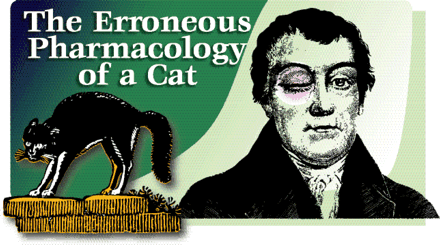The Erroneous Pharmacology of a Cat
In the spring of 1791, James Woodforde, the parson of Weston Longville in Norfolk, England, developed a painful sty on his right eyelid. Parson Woodforde, however, knew how to treat it: “As it is commonly said that the eyelid being rubbed by the tail of a black cat would do it much good, if not entirely cure it, and having a black cat, a little before dinner I made a trial of it, and very soon after dinner I found my eyelid much abated of the swelling and almost free from pain.” He concluded that a cat's tail was of the greatest service for such a condition (1).
The testimonial, someone speaking from experience, is psychologically one of the more powerful forms of persuasion. Eyewitness testimony is basic to the legal process. The testimonial satisfies an inductive element in us, the element that yields the pleasure of generalizing from the specific cases of a Dear Abby column or the plot of a novel. In science, however, the testimonial has little evidentiary value, although it may justify further investigation of a phenomenon.
Shortcomings of testimonials include the triumph of hope or expectation over experience, perhaps a form of the placebo effect. Testimonials often involve the fallacy of post hoc, ergo propter hoc, that is, the assumption that because two events occur sequentially, the first is the cause of the second. The swelling of the eyelid may have abated of its own accord even in the absence of the tail of the black cat. There is, moreover, a selection bias in testimonials: a lack of consequence rarely results in a testimonial. Dead men tell no tales: those with a favorable outcome—or those still surviving—are likely to be the ones offering the testimony. Other problems include the uncontrolled nature of patient testimony: On the one hand, there may be confounding variables not considered by the patient. On the other hand, patient reports are self-selected and unblinded in that the patient knows what the intervention was.
Woodforde's example illustrates the enduring human desire for miraculous solutions to the ills of existence: the quick intervention that will instantly cure; the sequence of digits that will bring untold wealth from the lottery; the regimen that will restore sexual prowess to the aging; or the pill that will help the obese to lose weight without the distraction of having to modify behavior. The more bizarre the intervention, the greater is the faith in efficacy. Not just the root of hemlock, but “the root of hemlock digged i' the dark.” Not the fur of a tabby cat or black dog, but the fur of a black cat, with its implications of witchcraft.

A century before Woodforde, in 1663, Queen Catharine, wife of Charles II, had pigeons placed on her feet to treat her fever. The following year, Samuel Pepys was unsure whether his good health was due to taking turpentine every morning or wearing a hare's foot. On feeling costive a few months later, however, no sooner did he handle a hare's foot than he broke wind and had a looseness of the bowels.
The way of thinking about natural phenomena exemplified in these reports is still common. Mass education and the advantages accruing from rationality are opposed by magical thought, blind hope, and a deluge of advertising that happiness is obtainable with the right item of clothing, automobile, cosmetic, or pill. Perhaps the majority of the population takes herbs, food supplements, or preparations derived remotely from various ethnic systems of folk medicine.
In contrast to Woodforde is the scientific approach to testing and efficacy exemplified by William Withering (1741-1799), born in Shropshire and graduated with an MD from the University of Edinburgh. Withering's interests ranged from chemistry and minerology—witherite (barium carbonate) is named for him—to botany. Modern pharmacology can be considered to date from Withering's book, An Account of the Foxglove, published in 1785. With this book, Withering introduced Digitalis for the therapy of congestive heart failure, or dropsy, as he knew the condition. Withering was unaware that dropsy was caused by cardiac insufficiency. However, as an objective clinical observer, he noted the actions of foxglove on the heart, writing that “…it had a power over the motion of the heart, to a degree yet unobserved in any other medicine, and that this power may be converted to salutary ends.” By salutary, he means healthful, or therapeutic. In other words, he recognized that toxic effects could be ameliorated to beneficial purpose.
In common with his times, Withering believed that the kidney was responsible for dropsy and therefore the site of action of Digitalis in the condition. However, his clinical observations were precise: “Let the medicine therefore be given in the doses, and at the intervals mentioned above; let it be continued until it either acts on the kidneys, the stomach, the pulse or the bowels; let it be stopped upon the first appearance of any one of these effects, and I will maintain that the patient will not suffer from its exhibition, nor the practitioner be disappointed in any reasonable expectation.” Withering thus identifies desired endpoints to be increased urine production (now thought to be due to increased cardiac output and increased blood flow through the kidney) and a decreased pulse rate (due to improvement in cardiac performance as afterload is decreased, with decreased activation of the sympathetic nervous system). He also spots the toxic manifestations of nausea and diarrhea. Furthermore, Withering notes the toxic central and cardiac manifestations: “The foxglove, when given in very large and quickly repeated doses occasions sickness, vomiting, purging, giddiness, confused vision, objects appearing green or yellow … slow pulse, even as slow as 35 in a minute.”
Withering learned about herbal treatment for dropsy from an old woman in Shropshire. However, her herbal recipe contained more than twenty plants. It took a prepared mind to determine which plant was responsible for the therapeutic aspect. Here, the catholicity of Withering's knowledge bore fruit, for he was a skilled botanist, having published in 1776 a two-volume text entitled A Botanical Arrangement of all the Vegetables Naturally Growing in Great Britain. Furthermore, the folk use of the Shropshire woman's material consisted in giving it until violent vomiting and purging (diarrhea) ensued. Withering recognized that these consequences were not needed for a therapeutic effect, but that diuresis was needed, and that this could be achieved at a lower dose. Withering also recognized the variability in activity of the Digitalis leaf and the need to standardize the preparation, which he accomplished by collecting leaves only from flowering plants, and drying them carefully. The consequences of not paying attention to dose could be serious. Withering reported on a visit to one patient: “I found him incessantly vomiting; his vision indistinct, his pulse forty a minute . . . His wife had stewed a large handful of green foxglove leaves in half a pint of water, and given him the liquor, which he drank at one draft . . . This good woman knew the medicine of her country, but not the dose of it, for her husband narrowly escaped with his life.”
Subsequently, digitalis preparation was standardized by bioassay. For many years, the official method for standardization according to the US Pharmacopoeia was ventricular arrest in frogs. Mammalian bioassays included pigeon emesis, and cat or guinea pig lethality. By the 1950s, digitalis was standardized in pigeon units, the dose required to produce death. However, the method yielded considerable variability. Indeed, digitalis has always been a dubious substance, with a narrow therapeutic index.
Recently, the sea change in cardiovascular therapeutics threatens to expel digitalis permanently from the pharmacopoeia as treatment of congestive heart failure. Digitalis is a positive inotropic agent, meaning it increases the force of cardiac contraction. It ameliorates symptoms and prolongs exercise tolerance. However, it is of doubtful safety or efficacy in prolonging life. Recently, there has been better understanding of the importance of increased sympathetic nervous system activity in congestive failure. This increase is one of the body's main compensatory responses to the decrease in cardiac output in congestive failure and results in: (i) decreased sensitivity of the arterial baroreflex response to blood pressure, leading to loss of the tonic baroreflex suppression of central sympathetic activity; (ii) increased release of norepinephrine, leading to increased myocardial contractility, heart rate, and vasoconstriction; and (iii) diversion of blood from the kidneys to more vital organs, such as the heart, thereby activating the renin-angiotensin system that elevates blood pressure and decreases excretion of sodium and water by the kidneys. These responses are good in the short term but bad in the long. Although treatment with digitalis emphasizes improved hemodynamics, restoring hemodyamic balance fails to halt disease progression. The current approach is to reverse activation of the sympathetic nervous system and the renin-angiotensin system with agents such as spironolactone (an aldosterone receptor antagonist) and beta-blockers. These agents are negative inotropic agents (decreasing cardiac contractility) and represent a reversal, compared to digitalis, in therapeutic objective.
Withering's major contribution was not so much a discovery as the formulation of a way of thinking, a way of rationally approaching a therapeutic problem. His book stands as a textbook of clear thinking. Withering replaced the anecdotal basis of medicine with evidence-based medicine, derived from careful observation uncontaminated with prejudice. Thus, he helped undo a system of therapeutics that for so long had been based on the blind application of precepts from ancient writers and unsubstantiated principles such as the Doctrine of Signatures.
Withering's first achievement was in reducing herbal polypharmacy to the active ingredient. He quickly realized that the diuretic effects of a complex mixture were due to a species of Digitalis. In his care to standardize the activity of Digitalis, he implicitly recognized that there was a principle within the plant that was responsible for the action, and that the amount of this principle within the leaf was variable. He introduced to the science of therapeutics the notion that pure principles are better than crude preparations because doses can be better quantified to maximize therapy and minimize unwanted effects. Today, this notion has been extended to the therapeutic use of optically pure isomers.
Withering also differentiated between toxic and therapeutic actions, showing that these actions followed different dose-response curves. Traditionally, the material had been given until violent vomiting and defecation resulted, these toxic manifestations being confused as desirable endpoints. Careful dose-response studies by Withering established that the beneficial diuretic action was achievable at doses lower than those producing purgation. He paid careful attention to biovariability, noting that the activity of foxglove leaves varied with the season. By standardizing collection from flowering plants, he was able to standardize dosing. Withering also recognized the conditions for which Digitalis was not indicated. It had in fact been employed to treat tuberculosis, asthma, and epilepsy, in addition to dropsy.
Despite his experiences with Digitalis, Withering did not discount the value of ethnopharmacology and ethnomedicine. He recognized that “folk medicine” could provide valuable insights. On the first page of his book he wrote that the only way the pharmacology of plants can be ascertained is by studying effects on experimental animals or by “the empirical usages and experiences of the populace” (i.e., ethnopharmacology). In all, Withering established a paradigm of thinking that could be followed by thousands of others and that helped metamorphose the caterpillars of polypharmacy and herbalism to the butterflies of pharmacology, therapeutics, and experimental demonstration.
Encumbered in his Norfolk countryside, James Woodforde continued on his ignorant way, overindulging in mackerel and pork and rabbits and beef steak and onion stew. His cat continued to be useful: Woodforde noted that the weather changed whenever the cat washed both her ears, which, he says, “is an old observation and now I must believe it to be a pretty true one.” His brother recommended brimstone to him for the cramp, and in the advent of symptoms to hold it in his hand or put it on the affected part. “I did, as I apprehended at one time it was coming into one of my legs, and I felt no more advances of it. This I thought deserving of notice, even in so trifling a book as this.” His beliefs did not, perhaps, differ much from many of his compatriots. John Byng wrote in 1785, “After breakfast, and two fine basins of snail tea, which always is of sovereign use to my lungs, we walk'd down the village” (2). The engineer, James Brindley (1716-1772) advised, “to cure the ague, drink your own urine when warm. ”
Although few today would be persuaded as to the efficacy of Woodforde's black cat, the testimonial belief is one of the driving forces underlying the revival of herbalism. Even interventions with frankly negative outcomes can persist in the absence of objective measurement. Bleeding—or phlebotomy—persisted for centuries, and in many cases, quantities of blood were taken that would have floored a healthy adult. Charles II of England and George Washington are among those whose demise was hastened by the attentions of the phlebotomist. The history of medicine is replete with the enthusiastic embracing of procedures and interventions subsequently demonstrated to be deleterious. The twentieth century has seen, for example, hyperbaric oxygen for babies, and the practice of lobotomy. In the face of fashion, enthusiasm, political pressures and funding priorities, pharmacologists have the responsibility of ensuring that evidence-based therapies continue as a mainstay. The painful gains since William Withering and Parson Woodforde rest on a fragile base.
- © American Society for Pharmacology and Experimental Theraputics 2001

Ryan J. Huxtable




